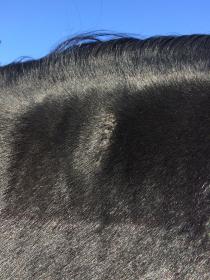I used to look at other parts of a horse, but now my eyes go straight to the pasterns.  At Rolex (it will always be Rolex to me) I saw several horses whose fetlocks almost touched the ground when weight bearing, even at a trot. And yet, here they are at a **** event. I wince when I see these horses in dressage, and I am gobsmacked when I think of those long and sloped pasterns going x/c.
At Rolex (it will always be Rolex to me) I saw several horses whose fetlocks almost touched the ground when weight bearing, even at a trot. And yet, here they are at a **** event. I wince when I see these horses in dressage, and I am gobsmacked when I think of those long and sloped pasterns going x/c.
Even more amazing (in a bad way) is a picture of one of the year-end champions in the hunter breeding division. The front pasterns are longer and more sloped than Goober’s. To think that this conformation is acceptable (and being rewarded) is very sad.
It seems to me, based on this relatively small survey that the difference between those horses and Goober, is the leg above the pasterns. These horses have very angular hocks. Again, I am assuming that these hocks absorb more than their fair share of the shock absorption, so the fetlocks are not responsible for carrying the entire load.
It would be interesting to have some of these sound, but suspiciously pastern’d, horses tested for DSLD. Perhaps when the test is not so invasive**, such a test will be carried out.
** Goober is now 7 (8?) weeks post harvesting of nuchal ligament from his neck. The site is still open and oozing bloody puss. My vet suggested that Goobs go to his clinic for a week to be treated intensively with antibiotics. And the clinic will not be charging me… Do we think that the vet is every bit as worried as I am?

 At Rolex (it will always be Rolex to me) I saw several horses whose fetlocks almost touched the ground when weight bearing, even at a trot. And yet, here they are at a **** event. I wince when I see these horses in dressage, and I am gobsmacked when I think of those long and sloped pasterns going x/c.
At Rolex (it will always be Rolex to me) I saw several horses whose fetlocks almost touched the ground when weight bearing, even at a trot. And yet, here they are at a **** event. I wince when I see these horses in dressage, and I am gobsmacked when I think of those long and sloped pasterns going x/c.
